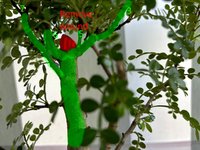Unagi
Seedling
- Messages
- 16
- Reaction score
- 14
- USDA Zone
- 8A
Background
I am a complete beginner, I bought my first two bonsais about 1.5 months ago, a Chinese pepper (Zanthoxylum piperitum) and a Chinese elm (Ulmus parvifolia). I was ripped off, but I didn't know that at that time.
The shop was a 3x3m wooden building next to a very busy road in the center of big city in Eastern Europe. There were wide windows on every wall of the building, and after they placed the shelfs that they put the bonsais on, there was only 1x1.5m remaining space inside. It was probably an ice crème or hot-dog stand before. The summers in that country are hot, that day, it was ~40C outside, so they placed a mobile AC to the 1x1.5m room that blow the ice cold air to the tree and the owner of the shop. Later I learned that they had a closed nursery outside the city, and they cycled the trees between the two places, that is how they kept the trees more or less green. The poor Chinese elm had plenty of dried out and yellow leafs, but it had green ones too! The trees were about 20 cm tall. Later, I noticed that the pot of the Chinese pepper was broken and glued together in a very ugly way. The Chinese elm was slip potted into a different medium that later caused me hard time to properly water it.
The trees were about 20 cm tall. Later, I noticed that the pot of the Chinese pepper was broken and glued together in a very ugly way. The Chinese elm was slip potted into a different medium that later caused me hard time to properly water it.
I paid about 50 USD per tree, but I was really happy that I bought my first bonsais.
When I travelled back to Switzerland, I brought the trees home, and started to read what makes a bonsai a bonsai. Nabari, trunk, etc. At this point I realized that the trees are probably not the best material for bonsai, or it can take a lots of time to develop them to a good one. Every cloud has a silver lining, I decided that is the best material for me to learn by experimenting.
In this post I would like to talk only about the Chinese pepper, and ask your opinion about what I would like to do, and what to pay attention to. I will write a similar post for my elm.
The tree
Here is the tree now. As you can see the trunk doesn't have a good taper, it is more like a stick in a pot. I was afraid of dig into the soil to see the roots, I will repot it next year and I will see how I can try to form it. Where the first branches start the trunk of the tree doesn't taper which makes it strange for me. Health wise, it doesn't have yellow leafs anymore (maybe it was just brought to the shop when I bought it), they are quite green with quite a few new leafs developing. What I don't know if it is a disease or the characteristics of the tree is the sometimes black bark.
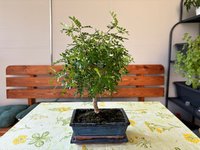
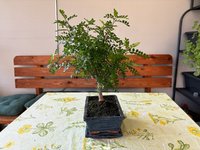
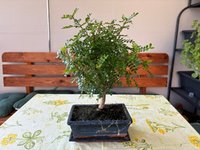
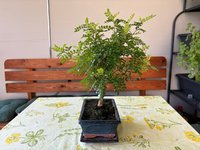
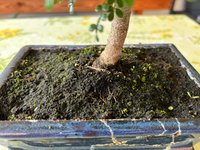
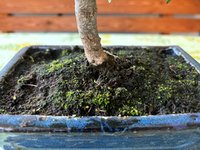
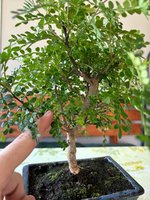
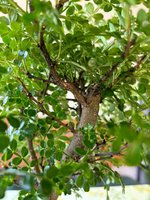
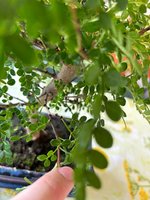
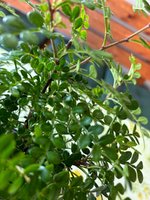
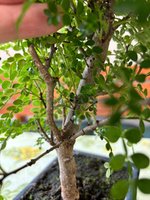
Goals
After examining the characteristics of the tree, I decided it can give me a good opportunity to learn about the followings:
- Propagation by air layering
- Propagation by cuttings in different soil types (organic and inorganic)
- Trunk development by cut and grow
- Trunk development by putting its pot to a bigger pot (I don't know if this technique has a name)
- Trying out different soil types for the whole bonsai (organic and inorganic)
- Repotting
- Root development by selecting good roots during repotting
- Healing an ugly wound at the top of the trunk
High level plan
The two most urgent decisions will be the cuttings and the air layering. I plan to air layer the tree to half, so I can develop a good taper for both trunks (even if they will be small at the beginning), and I want to prepare that with cuttings. The following picture show where I would like to air layer the tree next year.
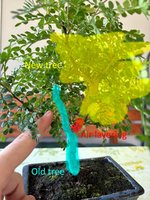
The cuttings are more tricky to show on pictures, I added a few examples.
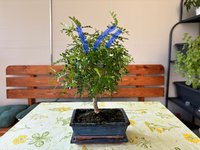
The repotting, root development, and healing the wound at the top of the trunk will be a topic for next year.
First action
I would like to try to propagate the tree by cuttings tomorrow. It is the end of the summer, probably the last chance to do it this year. I know where I will do air layering, and I want to prepare the tree for that.
I cannot show the exact branches I will plan to cut, but in general, I plan to do the following:
- Every place where more than 1 branch started to develop, I select only one to keep.
- I select one that goes to a good direction (based on where I want the trunk to go in the future), and the one that is relatively thick. I don't want to move the new trunkline with wire.
- I will not cut too small branches, I let them to grow a bit.
- I don't want to reduce the tree foliage besides what I mentioned above. First, I don't know how much the tree can withstand, and I want the tree to become stronger.
- I will help cover the cuttings with cut paste.
- I will propagate the cuttings with what we discussed here. I will use two different soil types, and I will use clonex gel.
My doubts
- Hopefully I don't cut too much that will affect the health of the tree.
- Hopefully the time for making this change is not at the wrong time for this tree. I know other species can tolerate a lot of abuse, maybe this tree cannot.
- Hopefully the cuttings will root well late summer.
- I don't know if the clonex gel will help or hinders root development. I know it depends on the tree type.
- I don't know how often to water the cuttings in the green house afterward. I need to read about this later.
- I hope that black bark is not a disease that I spread among other cuttings.
Next
I need to read more about the other goals before I can present them to you.
Thank you for reading and the comments, stay tuned.
I am a complete beginner, I bought my first two bonsais about 1.5 months ago, a Chinese pepper (Zanthoxylum piperitum) and a Chinese elm (Ulmus parvifolia). I was ripped off, but I didn't know that at that time.
The shop was a 3x3m wooden building next to a very busy road in the center of big city in Eastern Europe. There were wide windows on every wall of the building, and after they placed the shelfs that they put the bonsais on, there was only 1x1.5m remaining space inside. It was probably an ice crème or hot-dog stand before. The summers in that country are hot, that day, it was ~40C outside, so they placed a mobile AC to the 1x1.5m room that blow the ice cold air to the tree and the owner of the shop. Later I learned that they had a closed nursery outside the city, and they cycled the trees between the two places, that is how they kept the trees more or less green. The poor Chinese elm had plenty of dried out and yellow leafs, but it had green ones too!
I paid about 50 USD per tree, but I was really happy that I bought my first bonsais.
When I travelled back to Switzerland, I brought the trees home, and started to read what makes a bonsai a bonsai. Nabari, trunk, etc. At this point I realized that the trees are probably not the best material for bonsai, or it can take a lots of time to develop them to a good one. Every cloud has a silver lining, I decided that is the best material for me to learn by experimenting.
In this post I would like to talk only about the Chinese pepper, and ask your opinion about what I would like to do, and what to pay attention to. I will write a similar post for my elm.
The tree
Here is the tree now. As you can see the trunk doesn't have a good taper, it is more like a stick in a pot. I was afraid of dig into the soil to see the roots, I will repot it next year and I will see how I can try to form it. Where the first branches start the trunk of the tree doesn't taper which makes it strange for me. Health wise, it doesn't have yellow leafs anymore (maybe it was just brought to the shop when I bought it), they are quite green with quite a few new leafs developing. What I don't know if it is a disease or the characteristics of the tree is the sometimes black bark.











Goals
After examining the characteristics of the tree, I decided it can give me a good opportunity to learn about the followings:
- Propagation by air layering
- Propagation by cuttings in different soil types (organic and inorganic)
- Trunk development by cut and grow
- Trunk development by putting its pot to a bigger pot (I don't know if this technique has a name)
- Trying out different soil types for the whole bonsai (organic and inorganic)
- Repotting
- Root development by selecting good roots during repotting
- Healing an ugly wound at the top of the trunk
High level plan
The two most urgent decisions will be the cuttings and the air layering. I plan to air layer the tree to half, so I can develop a good taper for both trunks (even if they will be small at the beginning), and I want to prepare that with cuttings. The following picture show where I would like to air layer the tree next year.

The cuttings are more tricky to show on pictures, I added a few examples.

The repotting, root development, and healing the wound at the top of the trunk will be a topic for next year.
First action
I would like to try to propagate the tree by cuttings tomorrow. It is the end of the summer, probably the last chance to do it this year. I know where I will do air layering, and I want to prepare the tree for that.
I cannot show the exact branches I will plan to cut, but in general, I plan to do the following:
- Every place where more than 1 branch started to develop, I select only one to keep.
- I select one that goes to a good direction (based on where I want the trunk to go in the future), and the one that is relatively thick. I don't want to move the new trunkline with wire.
- I will not cut too small branches, I let them to grow a bit.
- I don't want to reduce the tree foliage besides what I mentioned above. First, I don't know how much the tree can withstand, and I want the tree to become stronger.
- I will help cover the cuttings with cut paste.
- I will propagate the cuttings with what we discussed here. I will use two different soil types, and I will use clonex gel.
My doubts
- Hopefully I don't cut too much that will affect the health of the tree.
- Hopefully the time for making this change is not at the wrong time for this tree. I know other species can tolerate a lot of abuse, maybe this tree cannot.
- Hopefully the cuttings will root well late summer.
- I don't know if the clonex gel will help or hinders root development. I know it depends on the tree type.
- I don't know how often to water the cuttings in the green house afterward. I need to read about this later.
- I hope that black bark is not a disease that I spread among other cuttings.
Next
I need to read more about the other goals before I can present them to you.
Thank you for reading and the comments, stay tuned.
Last edited:
















